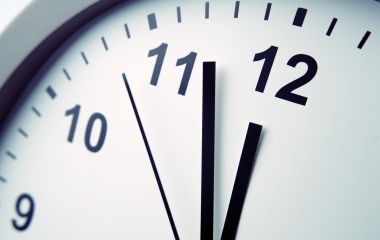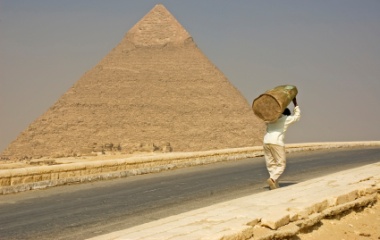
“And it was at the end of four hundred and thirty years, in the middle of that very day, that the legions of G-d went out from the land of Egypt” (Shemot 12:41). After 430 years, does it really matter what day and what time of the day we left Egypt?
Redemption is both an event and a process. It can simultaneously happen both in a day and yet take 430 years. “It was at midnight, that the Lord smote all the firstborn in the land of Egypt, from the first-born of Pharaoh that sat on his throne unto the first-born of the captive that was in the dungeon; and all the first-born of cattle” (12:29). In one moment redemption had arrived. Hours earlier, the Jewish people in a singular act of courage had taken the Egyptian god and slaughtered it. With that one act of defiance they were slaves no longer, and were a redeemed people. “Some acquire their world in one moment” (Avodah Zara 18a).
Yet that day was the culmination of 430 years. The seeds planted by Abraham would take centuries to develop. When Abraham was about to sacrifice Isaac, he could not envision how his descendants would be a great nation; but he was laying the foundation for that great nation. Maaseh avot siman lebanim, the actions of the fathers foreshadowed what would happen to the children (see Ramban, Breisheet 12:8).
Yet the Exodus was only the beginning of the redemptive process. While we often think that the redemption was complete with the receiving of the Torah, such is not the case—redemption is only complete once the Temple was built. The Ramban notes (see his introduction to Shemot) that Sefer Shemot is known as sefer hagalut vehageulah, the Book of Exile and Redemption. As galut means exile, geulah must mean returning home. Had redemption been complete at Sinai, Shemot would have ended at that point. Yet the book goes on to describe in great detail—more detail than the Exodus or divine revelation—the building of the Mishkan. That Mishkan was a temporary structure that would be replaced by the Temple in the land of Israel. Only at that point would the redemption be complete. And that would take a long time. “And it was in the four hundred and eightieth year after the children of Israel came out of the land of Egypt, in the fourth year of Solomon's reign over Israel, in the month Ziv, which is the second month, he build a house to the Lord”.
Redemption derives from man meeting G-d in history. G-d could not have redeemed us from Egypt if we had not sprinkled the blood of Egyptian god on our doorposts. Exodus, yes; redemption, no. On Pesach, redemption was initiated by G-d, with the Jewish people being mostly passive. But there is another form of redemption—where man takes centre stage and G-d is “hidden”, working quietly in the background. This is the redemption of Purim[1], a redemption led by Esther and Mordechai, with G-d not even getting a passing reference.
Yet the redemption led by man is just as slow a process, if not a slower one. Purim does not even seem like much of a redemption at all. True, we were saved from annihilation, but the lack of a negative does not equal a positive. Unlike Pesach, the Jewish people were not in a better situation at the end of the story than they were at the beginning. There was no return to Israel, no Temple—rather, the Megillah ends by recording the taxes levied by Achashverosh. We were, in the words of the Talmud, “still slaves to Achashverosh”. And it is this “slavery” that explains why Hallel is not recited on Purim. Yet Purim ushered in a new stage in Jewish history, where sages replaced prophets and man takes centre stage in the unfolding of Jewish law and Jewish destiny. According to our Sages, soon after the Purim, the second Temple was built. The fact that such does not appear in the Megillah highlights the fact that we may be laying the groundwork for redemption without even realizing it.
On Pesach, we celebrate not only the past redemption of the Jewish people, but the future one as well[2]. We are the fortunate generation witnessing redemption[3] before our very eyes. Like the redemption from Egypt, this redemption both takes place in a day, and is a process lasting many years. The Jewish people began returning the land of Israel about 200 years ago, and have been sovereign in the land for 66 years. There have been great redemptive moments as the greatest miracle of Jewish history unfolds before our very eyes. But the process is a slow and torturous one. There is much to be concerned about. We have returned to Jerusalem, yet we must still end our seder with the prayer, "next year in Jerusalem". May our generation merit the complete redemption: “and we shall say before Him, a new song."
[1] That Gemara explains that in a leap year, Purim is to be celebrated in the second Adar, so that we “may juxtapose one redemption to another”. The redemption led by G-d and that led by man are flip sides of the same coin.
[2] It is the meal that separates the past from the future. We begin by eating matza and marror, reflecting the past, and finish with the korban pesach, which is only eaten when redemption is complete.
[3] Notwithstanding anything written above, I must stress the dangers of basing decisions and policies on our limited understanding of the redemptive process. Such actions have brought only suffering in the past. I much prefer the model of such luminaries as Rav Yaakov Reines (founder of the Mizrachi movement) and Rav Soloveitchik, whose support of Zionism was devoid of messianic overtones.



